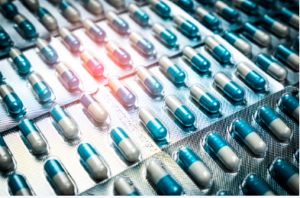But due to their many advantages for manufacturers, pharmacies, and patients alike, blister packs have increasingly become the packaging option of choice for medications.
 This aqua, commonly-shaped medicinal bottle is imprinted with LINDSEY’S COUGH BALSAM and features a crudely rolled finish and “whittled” look. Blown-in a key base mould, its pontil scar dates back to mid-19th-century production.
This aqua, commonly-shaped medicinal bottle is imprinted with LINDSEY’S COUGH BALSAM and features a crudely rolled finish and “whittled” look. Blown-in a key base mould, its pontil scar dates back to mid-19th-century production.
Plastic
Plastic has become an essential element of pharmaceutical packaging because it ensures product safety, integrity and efficacy. Polyethylene Terephthalate (PET) tablet bottle packaging offers ideal storage environments for medication with excellent moisture-blocking and contamination protection capabilities; their lightweight yet robust construction withstands shipping and handling without issue.
Plastic differs from glass because it does not leach chemicals into its contents, providing a safer and more eco-friendly alternative to glass bottles. Furthermore, PET plastic bottles have tamper-evident features for extra patient security.
Paper
Paper tablet bottle packaging offers many advantages for pharmaceutical and retail pharmacies, from its biodegradability to being environmentally friendly. Paper meets FDA requirements for water, light and child resistance and is easily recyclable once full; its plant-based composition also meets organic standards.
Plastic has the disadvantage of being permeable to gases and liquids, making it less suitable as primary packaging than glass for drug distribution. Thus, secondary or tertiary packaging involving polyvinyl chloride, polyester or polypropylene plastics, such as vials, ampoules, dropper bottles or jars, tend to use these plastics.
Contract packagers offer pharmaceutical manufacturers an economical alternative to traditional bottle manufacturing with their variable floorspace and multifaceted equipment that can accommodate short or long runs of custom pharmaceutical packaging. Furthermore, their processes and training help ensure compliance with GDUFA, cGMP compliance, serialisation readiness and GDUFA. Contract packagers collaborate with drug makers to communicate dosage information through design or print; some contract packagers even adhere extended content labels directly onto pill bottles or blister packs!
Metal
Pharmaceutical production requires tablet bottle packaging to fulfil numerous criteria. It includes protecting drug products from physical and chemical deterioration, being stable and compatible with other packaging components and being permeable to common gases such as oxygen, carbon dioxide and water vapour; while also considering how these gases absorb odorous gases and volatile ingredients, which could limit shelf life.
Packaging options for tablets and other solid dosage forms vary, such as glass, plastic and sachets. When selecting packaging material for tablets or other solid dosage forms, the most critical consideration should be its barrier properties; other considerations must include the type of drug being packaged, its target patient group and legal requirements.
Other than its protective qualities, packaging must also be attractive enough to draw patients’ interest and hold onto it. An appealing packaging design must provide clear information about the drug, its uses, and safety information about how best to use the product safely. Tamper-proof packaging that meets regulatory standards must also be resealable using shrink bands or hot air sealers such as PVC.
Glass
Glass packaging offers an eco-friendly option today, as its natural composition means it is non-toxic. Furthermore, its impervious surface prevents liquids and gases from reaching its interior, while different colours protect its contents from sunlight damage. Furthermore, heat resistance makes glass suitable for hot foods like jam or terrine.
Glass packaging combines various shapes, sizes, and colours to complement product and brand images. It can be manufactured through either the press-blow process, using compressed air jets to form glass blanks, or blowing molten glass into moulds – both methods produce high-quality pharmaceutical bottles.
Pharmaceutical industries utilise glass tablet bottle packaging for various products, such as tablets and capsules. Bottles may be constructed of either borosilicate or soda-lime glass depending on the characteristics of each product, with borosilicate being more stable due to being resistant to chemical reactivity, while Soda-lime glass (known as type III glass) serves food applications.
The FDA regulates glass and plastic containers used for food storage to ensure they comply with food safety requirements, with manufacturers required to ensure these are suitable. They should not contain indirect additives that might compromise food or beverages and should be made from durable material that can withstand different temperatures without damage; additionally, they must be easily washable and carry labels without the risk of defacing their surface.